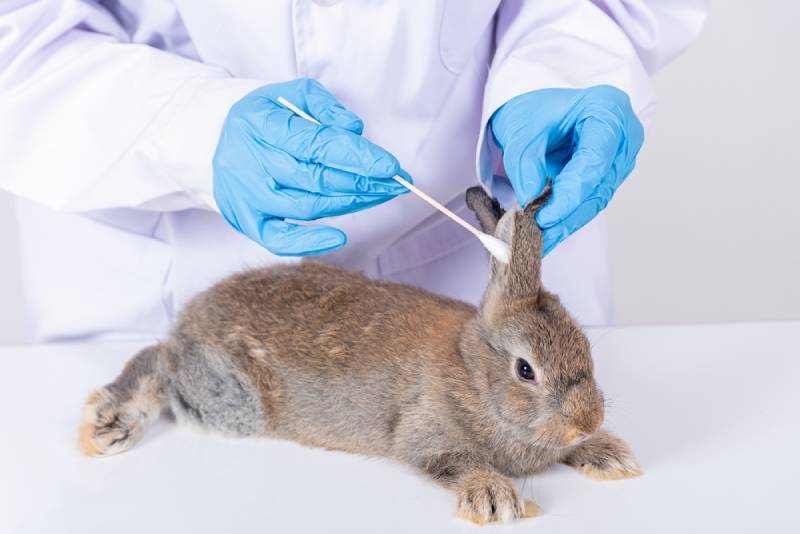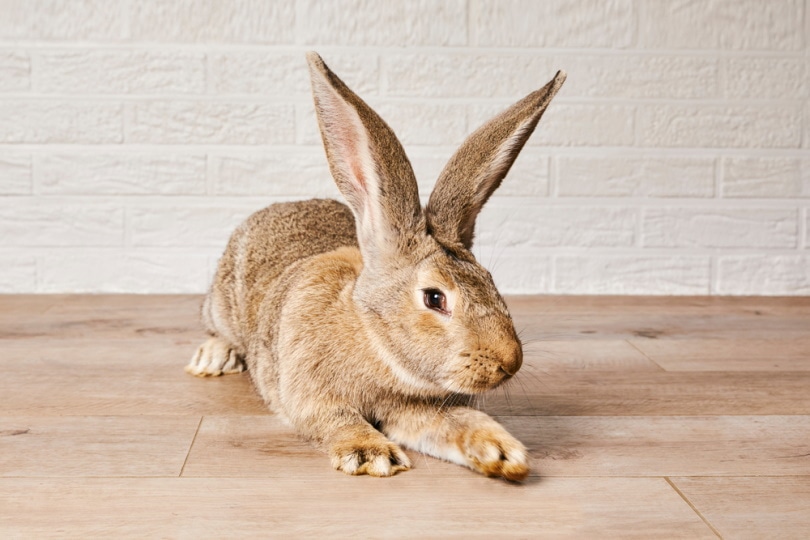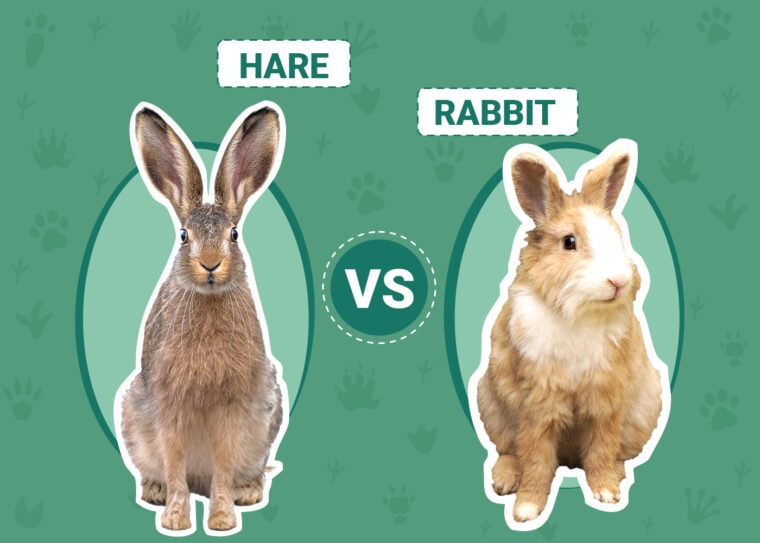
Click to Skip Ahead
To the naked eye, hares and rabbits look the same. That’s why these terms are often used interchangeably. However, there are quite a few differences between these lovely animals. First, hares are much bigger, stronger, and faster than bunnies. Secondly, they’re not nearly as sociable or friendly because they’ve never been domesticated. When facing a predator, hares rely on their agility and speed to run away, while buns prefer to hide instead.
At the same time, rabbits are more open, trusting, and happy to bond with humans. Does that mean hares are a bad choice as pets, then? Or maybe you can train one into an obedient, happy companion? It’s time to set the record straight! So, today, we’ll go over the size, appearance, lifespan, temperament, diet, and natural habitat of hares versus rabbits and cover both the differences and the similarities. Stay tuned!
Visual Differences

At a Glance
Hare Overview

Personality / Character
Hares are used to living and surviving in the wilderness and have to rely on themselves solely. That’s why they’re standoffish and suspicious toward humans. This might come as a surprise, but most hares prefer to live solitary lives. Yes, some jacks and jills do become partners and live in pairs, but you won’t ever see hares forming large groups and sticking together. By nature, they are shy and not very social: that’s their way of life. Now, the Belgian hare could be called an exception to that rule.
However, in all fairness, it’s a rabbit, not a “true” hare. It’s been bred to resemble the appearance and physical properties of a hare, but, again, for all intents and purposes, it is a bunny.
Appearance
Compared to bunnies, hares are significantly bigger and stronger (even when compared to the largest rabbit breeds). Hares are incredibly fast, too, thanks to their long hind legs, mighty muscles, and enduring nature. Next, while some bunnies do rock big ears, they’re still substantially smaller compared to what the hares have. And the large ears aren’t there only for the looks or to provide better hearing. When it’s hot outside, they do a great job of dissipating heat.
And what about the fur, you might ask? Well, quite a few hare breeds are known for their incredible ability to change the color of the coat. For example, when it starts to snow, they go all-white for the season. This is a defense mechanism, of course, and it allows these highly energetic animals to hide from predators while navigating through the wilderness.

Natural Habitat / The Litter
Hollowed-out trees, big rocks, and nests in open fields: that’s where hares mostly live. As mentioned, hares are incredibly fast and have lots of stamina, which is why they prefer to “pack light” and stay on their feet instead of setting up shop in one place. Mobile by nature, they often switch homes in search of a better place in terms of food, safety, and living conditions.
If we take a quick look at the gestation period, we’ll see that it lasts for 38 to 46 days (mostly 42). And the fascinating thing about hares is that their babies (called leverets) are born with their coats on and can start running just 1–2 hours after birth. Yes, as far as the most self-sufficient animal babies go, hares are right on top of the list. Also, hares are much faster than rabbits: 45 mph versus 35 mph.
The Diet
Hares aren’t big fans of veggies, fruits, or other treats. Instead, they mostly chew on hay, grass, bark, and twigs (rough, woody stuff). During spring and summer, hares feed on grass and leaves, but when it gets cold and the snow covers the ground, they switch to trees and shrubs (the bark and twigs). Fun fact: an adult hare can devour up to 2 pounds of greens per day!

Good As Pets?
Hares are not domestic animals— they never have been. And that’s exactly why they’re rarely picked as pets. Wild hares are almost impossible to tame and won’t be happy locked up in an apartment. So, no, they’re not good pets unless you have acres of land and are ready to accept the idea that the hare might never warm up to you. Chances are, it will run away the second it gets the chance. This is true even if you breed and raise the pet (say, a European hare) from day one.
Suitable For:
Due to their natural habitat, temperament, and way of living, hares aren’t the best pets for the average family. If you have little children/seniors in the house, they won’t be able to keep up with the hare, and it will quickly turn into a nuisance. Also, no matter how much effort you put into socializing them, these animals will still long for the wilderness: that’s where they belong. Therefore, people in the market for an affectionate, cuddly pet should pick rabbits instead.
Rabbit Overview
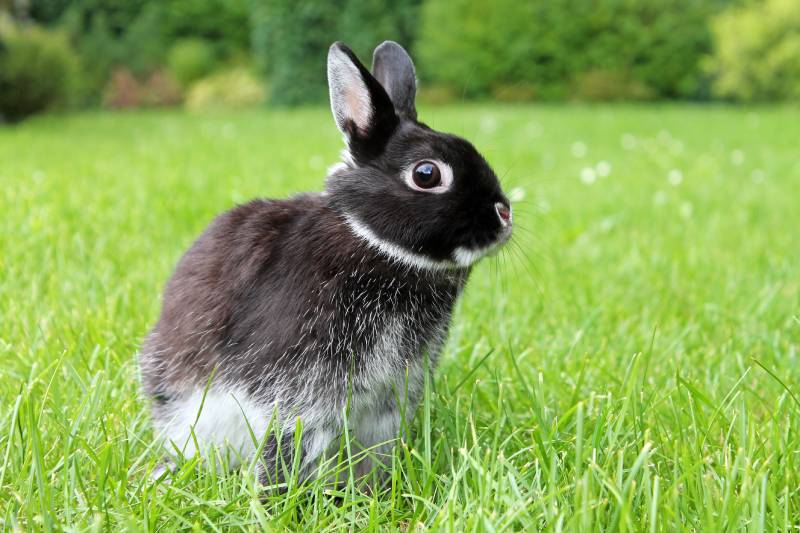
Personality / Character
Very few mammals are as fun and friendly as rabbits. They are quick to share their happiness with the world by doing binkies. At the same time, some rabbits are a bit shy and don’t like to be touched or cuddled. But, for the most part, they are incomparably more open, trusting, and obedient than hares. That’s one of the biggest differences between these animals.
On top of that, rabbits are used to living and eating in large groups (up to 20). Male rabbits are often seen fighting to get the attention of the ladies, but they still stick together. On their own, most bunnies get lost and eaten by a fox, coyote, or even a bird. If you want to have a pet rabbit, do consider adopting two instead; otherwise, the bun might get lonely and develop separation anxiety.
Appearance
Bunnies are roughly 50% smaller than hares. On average, they reach 12–17 inches in height and up to 6 pounds in weight, while hares can be as tall as 30 inches and come in at 6–12 pounds. Plus, the ears aren’t nearly as big, while the legs are much shorter. Like hares, rabbits shed their fur each year, but they don’t switch colors. Instead, the coat’s thickness/density is changed depending on the time of the year.
Both animals have roughly the same lifespan, though (up to 12 years). However, since many rabbits are domesticated, they have a much higher chance of making it that long. Hares, in contrast, often die before they go over 4–6 years old. Another thing that these animals have in common is the fact that they’re crepuscular (active at dawn and dusk).
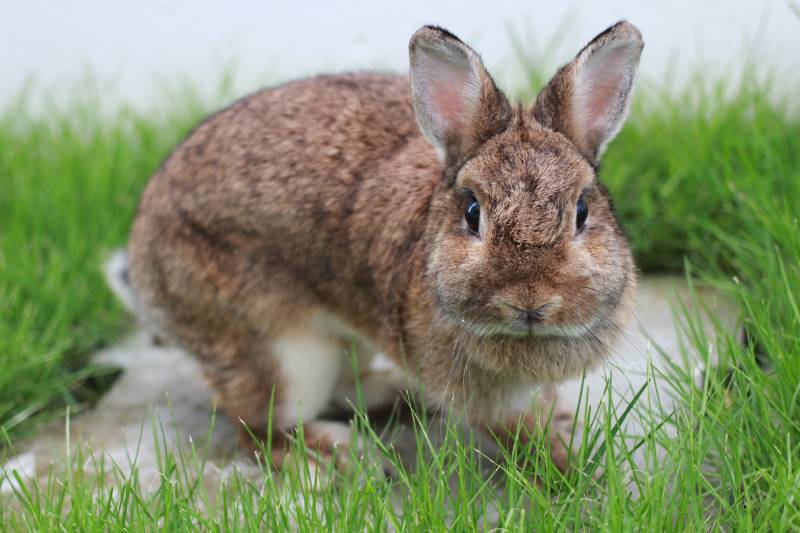
Natural Habitat / The Litter
In contrast to hares, rabbits can’t survive in an exposed habitat: you’ll rarely catch one running around in an open field. Instead, they pick areas with plenty of cover, dig burrows (underground tunnels), and spend most of their time there. These tunnels tend to be rather large and complex, and they allow dozens of bunnies to communicate with each other and weather the storm.
This is another thing that sets rabbits and hares apart: bunnies prefer to find a spot to hide in to avoid predators. The gestation period for rabbits is much shorter compared to hares (27–33 days). But baby rabbits (called kittens) are born blind and don’t have any fur. They rely heavily on their mothers, and it takes them weeks to become independent and be able to fend off foxes and wolves and feed themselves.
The Diet
Rabbits are big fans of hay but wouldn’t mind some grass, vegetables, and pellets. If you own a pet bunny and want to treat it with tasty snacks, talk it over with a veterinarian first. The thing is—their GI tracts aren’t built to handle high doses of sugar. So, while bunnies do like to munch on fruits, you should only feed them tiny bits of apples or, say, peaches. As for nuts, cookies, bread, and other baked stuff, it’s out of the question for bunnies.

Good As Pets?
Rabbits are the third most popular pets in the United States. They are curious, socially active balls of fur that are easy to take care of, don’t eat tons of food, and can be happy in a small apartment. If there are little kids in the house, you will have to do your fair share of supervision and early socialization. Still, bunnies are incredible pets that will bring lots of joy into your home.
Bunnies don’t need any expensive toys, cages, or supplements. You won’t have to walk them early in the morning, either.
Suitable For:
Rabbits are best suited for families with adult children that don’t have the time or energy for a high-maintenance pet. While rabbits can be very active, they aren’t at all clingy and take little effort to maintain. Once you go through potty training and create a strong bond with the bun, it will quickly turn into your new best friend. Folks that have to work long hours and don’t have enough room for a freedom-loving pet will also appreciate rabbits.
Which Breed Is Right for You?
If you’re looking for an easy-to-train, affectionate, and cute pet, go with a bun. Rabbits are smart, quick to adapt to apartment living, and happy to be around humans they love and trust. Hares, in contrast, don’t know how to be domestic animals, as they’ve never had their experience. They are wild animals, in and out, and will always choose the wilderness over the coziest home.
That’s why wildlife rescue services, animal shelters, and breeders don’t recommend them as domestic animals. Even the Belgian hare (which, technically, is a rabbit) is shy, nervous, and prefers to be outside rather than inside. Summing up, rabbits are the obvious choice as pets. They’ve been domesticated for thousands of years and are accustomed to living side by side with us.
See also:
- Bunny vs. Rabbit: Is There a Difference? Facts & FAQ
- Wild vs. Domestic Rabbits: Differences Explained (With Pictures)
Featured Image Credit: Top – TheOtherKev, Pixabay | Bottom – Preediwat, Shutterstock




